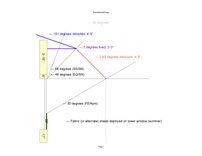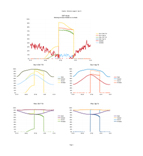This is a heating dominant climate. It gets cold. With that being said, it is also high desert, and gets pretty hot during June through September. The sun shade has always been a part of the design, as of yet it is not done. John has proposed a few designs, but his first one I liked better than the others. My point is that you cannot have a full fixed sun shade in this area; either it will be ok for the summer months, and shade way too much in the spring causing additional heating requirements, or it won’t shade enough in the summer and cause an additional cooling requirement. Thus I have always pushed for a dynamic, seasonal sun shade; one that can be deployed when needed (3 months) and retracted when heating is needed (the other 9 months). This isn’t as easy as it sounds, as anything which is movable adds complexity (and therefore cost). The sun shade is not light as it is made out of grating, thus retracting it is not a trivial process. Those details have to be ironed out. The requirements I gave John was that (1) the sun shade had to block all incoming light prior to fall equinox at 4pm when deployed, and (2) let all light through up to and including summer solstice when retracted. That is a big order.
So, with all that input in mind, I designed the following sun shade. It is a sun shade made up of two sections (i.e., “double”) (a) fixed horizontal out from the parapet, then (b) a movable part at a 45 degree angle to the horizontal. With this current design (see links below), I allowed for push back on the second design requirement (all light is let through to the equinoxes when retracted (up to a 46 degree sun altitude angle), and gets occluded towards the summer solstice). This only matters in spring, for in summer the shade is deployed for full shading. So, the two design compromises are: (1) fixed blocking to a 46 degree angle (equinox) instead of just to a 69 degree angle (solstice) as stated above, and (2) using a grid spacing of 1 inch on the movable grating compared to 1/4” spacing (7-SG-4 top and
19-SG-4 bottom grating). The chart graph file below shows the expected blocking degradation for each of these compromises. Per John’s statement: the retracted degradation in spring can be made up somewhere else, i.e. a small number of additional solar panels. The deployed degradation in summer, on the order of 10% at its worst, is not that significant. The actual moving mechanism and support struts and posts have yet to be worked out.
Note: Generic 65F heating degree days and 80F cooling degree days are shown on the chart, but what is much more important is the direct solar gain data which drives the passive heating. (Review the Thermostat, Temperature and Weather Logs data.) I have yet to get that data and find the proper factors for fitting it.
Note: I optimized the angles and lengths to minimize the square footage of the movable section, but it turned out that those fit John’s angles on the retaining walls almost to a “T”. Not bad!
Further work: I tweaked the shade design more to get better spring performance, at the expense of matching the top of the retaining wall and adding back in a double hinge for the south grate; but this double hinge is a lot better than the original one since it is off of a fixed support point. I was able to run a complete yearly analysis.
|




